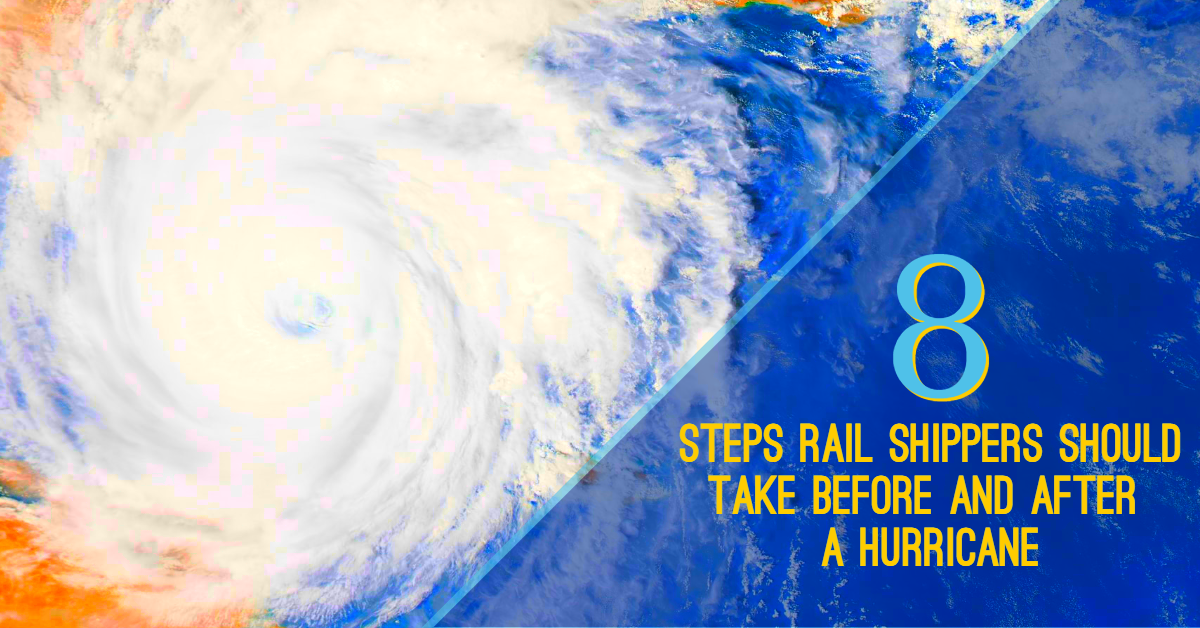Hurricanes can have devastating impacts on supply chains. As much as we’d like to avoid them altogether, there is no controlling Mother Nature. What we can control, however, is how we prepare for and recover from hurricanes.
If you’re a rail shipper and want to reduce the supply chain impacts of storms, follow these tips. Doing so will reduce damage to rail cars, allow you to make the most of the railroad’s resources and ultimately expedite local service recovery time.
Before the Storm
- Five days before: Divert cars. If your facility is in the path of a storm, you’ll want to divert any rail cars headed your way. Sending cars to an alternate location and reducing inventory levels at your plant will reduce the potential for mechanical damage the storm could cause to rail cars – and will also protect the products inside.
- Three to four days before: Work with the railroad. You’ll want to notify the railroad of any special service requests ASAP. They can help you manage your inventory and divert cars in advance of the storm.
- One to two days before: Communicate your plant operations plan. What is your timeline for ceasing operations and/or evacuating the plant? Let the railroad know your plans. Doing so will allow them to place tracks out of service as needed and schedule rail cars appropriately to ensure resources are used effectively after the storm.
After Landfall
- Report track damage. Report any tracks that are damaged and/or out of service to the railroad.
- Provide a plant operations update. Let the railroad know the estimated time frame for repairs to your facility and when you plan to resume operations. This will allow the railroad to know when to place tracks back in service and deploy rail cars as needed.
- Request resumption of rail service. Once repairs are complete and you know when your plant will resume operations, notify the railroad and request for rail service to resume.
- Don’t move rail cars if water has reached the wheel bearing. Wait for the railroad to inspect the car and make sure it is safe to move.
- Inspect rail cars. Per the American Association of Railroads (AAR) interchange rules, any rail cars that have been damaged by flooding must undergo a joint inspection between the railroad’s mechanical team and personnel at your plant.
Steps for Union Pacific Customers
If you’re a Union Pacific Railroad customer, you’ll also want to consult the following resources in anticipation of — or during recovery following — a hurricane:
- The Hurricane Planning and Recovery Page details specific steps to take as a Union Pacific customer. This includes links to report a service issue, which allows you to:
- Report damaged or out-of-service tracks
- Communicate the timetable for ceasing plant operation
- Provide estimated facility repair time and resumption of operations
- Request service to be resumed when repairs are complete
The page also includes information on requesting diversions and rail car inspections as well as a list of current embargoes.
- Customer Care and Support for assistance specific to your shipments: 800-272-8777
- Response Management Communications Center (RMCC) to report emergencies: 888-877-7267
To learn more about how railroads take action in the event of a storm, visit the AAR’s article on how freight railroads prepare for and respond to extreme water.
How Do You Handle Hurricanes?
Do you have hurricane planning and recovery tips? We’d love to hear your stories and advice. Just shoot us an email to share. Or, want to learn more about shipping by rail? Answer a few questions and we'll connect you with an expert who can help.
Related Articles:
- Winter Weather Preparedness Tips for Rail Shippers
- What Is Precision Scheduled Railroading?
- APIs Are Changing the Logistics Landscape — Are You Ready?
- How to Be the Best Logistics Manager: 10 Secrets for Success
- Can B2C Supply Chains Teach B2B a Thing or Two?
- Site Selection: 9 Points to Ponder Before Choosing Your Next Industrial Location









